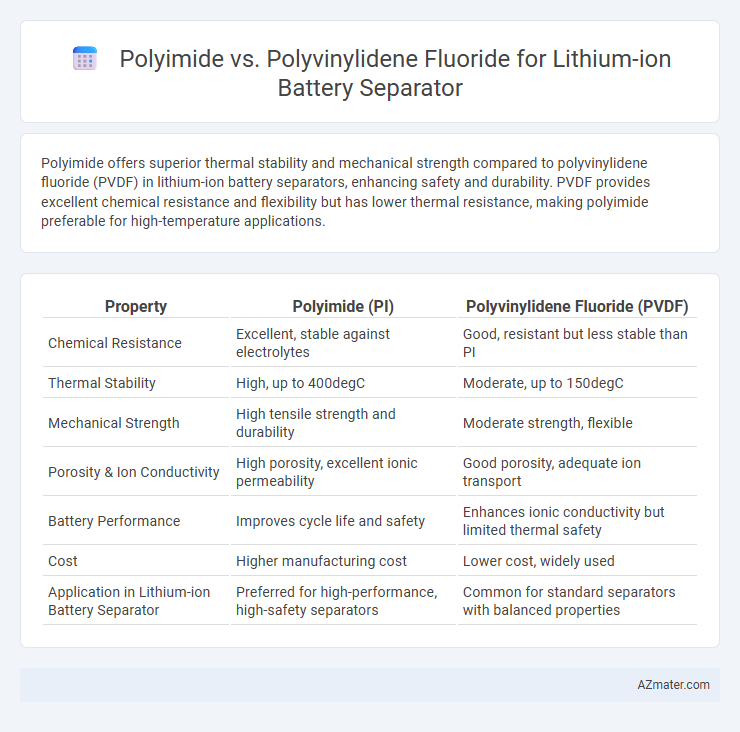Polyimide offers superior thermal stability and mechanical strength compared to polyvinylidene fluoride (PVDF) in lithium-ion battery separators, enhancing safety and durability. PVDF provides excellent chemical resistance and flexibility but has lower thermal resistance, making polyimide preferable for high-temperature applications.
Table of Comparison
| Property | Polyimide (PI) | Polyvinylidene Fluoride (PVDF) |
|---|---|---|
| Chemical Resistance | Excellent, stable against electrolytes | Good, resistant but less stable than PI |
| Thermal Stability | High, up to 400degC | Moderate, up to 150degC |
| Mechanical Strength | High tensile strength and durability | Moderate strength, flexible |
| Porosity & Ion Conductivity | High porosity, excellent ionic permeability | Good porosity, adequate ion transport |
| Battery Performance | Improves cycle life and safety | Enhances ionic conductivity but limited thermal safety |
| Cost | Higher manufacturing cost | Lower cost, widely used |
| Application in Lithium-ion Battery Separator | Preferred for high-performance, high-safety separators | Common for standard separators with balanced properties |
Introduction to Lithium-ion Battery Separators
Lithium-ion battery separators are critical components that prevent physical contact between the anode and cathode while allowing ionic conductivity. Polyimide separators exhibit excellent thermal stability and mechanical strength, enhancing battery safety under high temperatures. Polyvinylidene fluoride (PVDF) separators offer superior chemical resistance and flexibility, contributing to prolonged battery cycle life and efficiency.
Overview of Polyimide (PI) and Its Properties
Polyimide (PI) is a high-performance polymer known for its exceptional thermal stability, mechanical strength, and chemical resistance, making it an ideal material for lithium-ion battery separators. Its molecular structure provides a high melting point exceeding 400degC, excellent dimensional stability under harsh operating conditions, and superior electrolyte wettability, which enhances ionic conductivity. These properties contribute to improved safety and long-term performance in lithium-ion batteries compared to conventional materials like polyvinylidene fluoride (PVDF).
Overview of Polyvinylidene Fluoride (PVDF) and Its Properties
Polyvinylidene fluoride (PVDF) is a highly fluorinated polymer widely used as a separator material in lithium-ion batteries due to its excellent chemical resistance, high thermal stability, and strong mechanical properties. Its semi-crystalline structure provides good electrolyte wettability and ionic conductivity, which enhances battery performance and safety. PVDF's inherent hydrophobicity contributes to its ability to maintain separator integrity under aggressive electrochemical environments, making it a preferred choice for advanced lithium-ion battery applications.
Thermal Stability Comparison: Polyimide vs PVDF
Polyimide exhibits superior thermal stability compared to polyvinylidene fluoride (PVDF) in lithium-ion battery separators, maintaining structural integrity at temperatures above 400degC while PVDF typically degrades around 170-200degC. The high thermal resistance of polyimide enhances battery safety by preventing separator shrinkage and short circuits under high thermal stress. PVDF's lower melting point and thermal shrinkage limit its performance in high-temperature applications, making polyimide a preferred choice for advanced thermal management in lithium-ion batteries.
Mechanical Strength and Durability Analysis
Polyimide separators exhibit superior mechanical strength and durability compared to polyvinylidene fluoride (PVDF) counterparts, offering enhanced thermal stability and resistance to mechanical deformation in lithium-ion batteries. The inherent aromatic structure of polyimide provides exceptional tensile strength and dimensional stability, crucial for maintaining separator integrity during battery cycling. In contrast, PVDF separators, while flexible and chemically resistant, generally demonstrate lower mechanical robustness and may suffer from reduced long-term durability under high-temperature or high-stress conditions.
Electrochemical Performance Assessment
Polyimide separators exhibit superior thermal stability and mechanical strength, resulting in enhanced electrochemical performance in lithium-ion batteries compared to polyvinylidene fluoride (PVDF) separators. Polyimide's high electrochemical stability window and resistance to electrolyte degradation contribute to improved cycle life and ionic conductivity. In contrast, PVDF separators often suffer from lower thermal resistance and reduced dimensional stability, limiting their efficiency under high-rate charge-discharge conditions.
Chemical Compatibility and Resistance
Polyimide exhibits superior chemical compatibility and resistance to aggressive electrolytes in lithium-ion battery separators, maintaining stability under high-temperature and oxidative conditions. Polyvinylidene fluoride (PVDF) offers good chemical resistance but can degrade in prolonged exposure to strong solvents and high voltage environments. Consequently, polyimide is preferred for applications requiring enhanced durability and thermal stability in battery separators.
Separator Manufacturing and Processing Techniques
Polyimide separators for lithium-ion batteries are typically manufactured using solvent casting or electrospinning, offering superior thermal stability and mechanical strength compared to polyvinylidene fluoride (PVDF), which is commonly processed via phase inversion or melt extrusion techniques. Polyimide membranes provide enhanced electrolyte wettability and dimensional stability under high temperatures, crucial for advanced battery safety and performance. PVDF separators, while easier to process and more cost-effective, may require additional surface treatments to improve ionic conductivity and thermal resistance during separator fabrication.
Cost-effectiveness and Scalability
Polyvinylidene fluoride (PVDF) separators generally offer lower production costs and easier scalability compared to polyimide (PI) due to simpler synthesis processes and widespread industrial adoption. Polyimide separators deliver superior thermal stability and mechanical strength but often incur higher material and fabrication expenses, limiting cost-effectiveness for large-scale lithium-ion battery manufacturing. Evaluating lifecycle costs alongside performance metrics reveals PVDF as a more economically viable option for mass production, whereas PI suits applications demanding enhanced durability despite premium pricing.
Conclusion: Choosing the Right Separator Material
Polyimide offers superior thermal stability and mechanical strength, making it ideal for high-temperature and high-performance lithium-ion battery applications. Polyvinylidene fluoride (PVDF) provides excellent chemical resistance and flexibility but has lower thermal resistance compared to polyimide. Choosing the right separator material depends on balancing thermal stability, chemical compatibility, and mechanical durability tailored to the battery's specific operating conditions.

Infographic: Polyimide vs Polyvinylidene Fluoride for Lithium-ion Battery Separator
 azmater.com
azmater.com